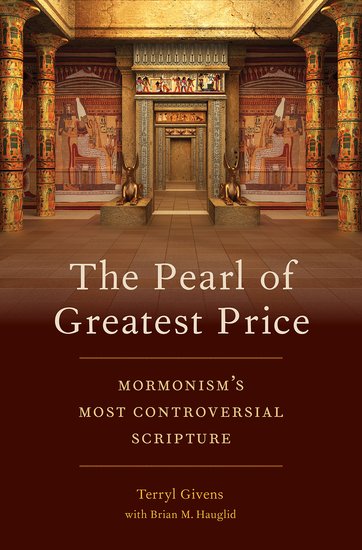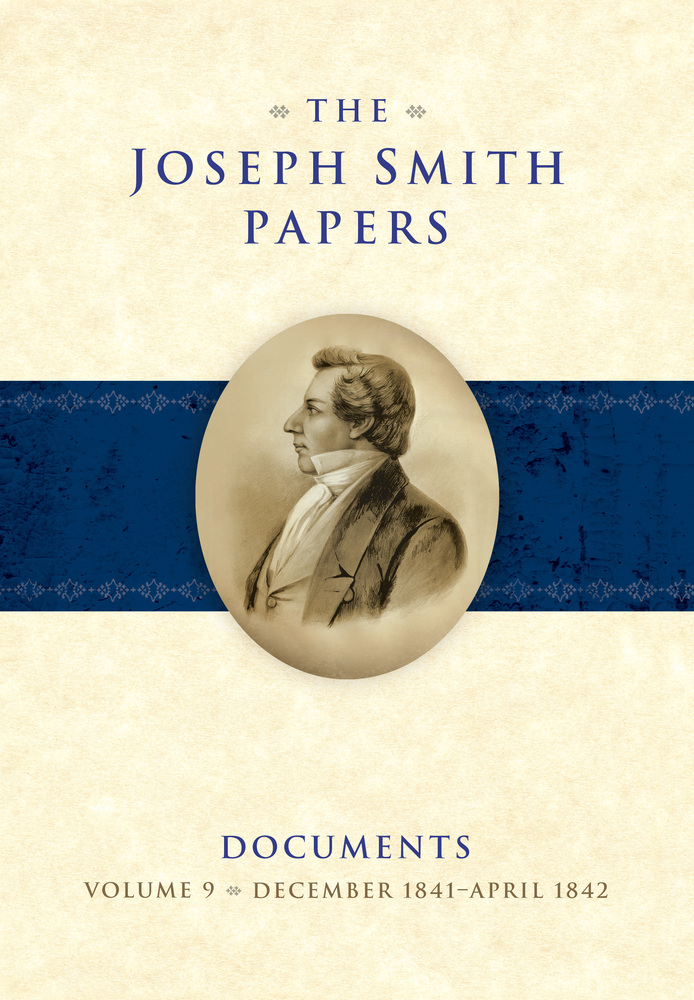
Most members of The Church of Jesus Christ of Latter-day Saints have probably never thought of the Pearl of Great Price as controversial. The Book of Mormon, yes—it has been under attack practically since the night Moroni appeared to Joseph Smith. Yet, Givens and Hauglid [1] use this book to argue that the Pearl of Great Price is even more so. Unfortunately, the majority of the effort goes into attempting to prove the point, and it leaves the book less than faith-promoting. It does have some bright spots, however.
The book begins with the assertion that “without the Book of Mormon, the Church of Jesus Christ would lose its principal evangelizing tool and its most conspicuous sign of Smith’s prophetic vocation but relatively little of its doctrine.… With the Doctrine and Covenants, the church would lose a good bit of its ecclesiology—organization templates and guidelines for church government and its offices—but would not suffer a devastating loss of the deeper theological underpinnings of its faith.” [2] I found these statements to be very surprising. The Book of Mormon has enough unique doctrine in it for Tad Callister to devote an entire chapter of his recent book to it, and in several places Givens admits that doctrine found in places like the Book of Moses was first taught in the Book of Mormon. In addition, the Doctrine and Covenants contains a great deal of unique doctrine, in spite of the removal of the Lectures on Faith (which the book points out is commonly thought to have been the Doctrine of the Doctrine and Covenants). A comparison of our edition with that of the Community of Christ shows some of what would be missing without it.
The book goes on to make its point: “Mormonism, in other words, is absolutely inconceivable apart from this collection of scriptural texts that provided the faith’s theological core from the beginning but only received canonical recognition in 1880. At the present moment, controversies regarding multiple accounts of Smith’s ‘First Vision,’ as well as the origins of the text of the Book of Abraham, have brought unprecedented attention to this hitherto largely neglected work. The consequence is that the Pearl of Great Price represents at one and the same time the greatest vulnerabilities and the greatest strengths of the Church of Jesus Christ.” [3] As I argue below, this is quite an overstatement. [Read more…] about Book Review: The Pearl of Greatest Price: Mormonism’s Most Controversial Scripture
 Angela Hallstrom works for the Church History Department as a writer and literary editor for the four-volume history of the Church, Saints: The Story of the Church of Jesus Christ in the Latter Days. Prior to her work for the Church History Department, she taught writing at the University of Wisconsin-River Falls. She received an MFA in creative writing from Hamline University and is the author of the novel Bound on Earth, editor of the short fiction collection Dispensation: Latter-day Fiction, and has served on the editorial boards of BYU Studies, Irreantum, and Segullah. She and her husband are the parents of four children, and recently moved back to Utah after spending sixteen years in Minnesota.
Angela Hallstrom works for the Church History Department as a writer and literary editor for the four-volume history of the Church, Saints: The Story of the Church of Jesus Christ in the Latter Days. Prior to her work for the Church History Department, she taught writing at the University of Wisconsin-River Falls. She received an MFA in creative writing from Hamline University and is the author of the novel Bound on Earth, editor of the short fiction collection Dispensation: Latter-day Fiction, and has served on the editorial boards of BYU Studies, Irreantum, and Segullah. She and her husband are the parents of four children, and recently moved back to Utah after spending sixteen years in Minnesota. Ben Spackman did ten years of undergraduate (BYU) and graduate work in ancient Near Eastern studies and Semitics (University of Chicago) before moving on to general science (City College of New York). Currently a PhD student in History of Christianity at Claremont Graduate University, Ben’s focus is the intertwined histories of religion, science, and scriptural interpretation; most specifically, he studies the intellectual history of fundamentalism, creationism, and religious opposition to evolution in connection with interpretations of Genesis.
Ben Spackman did ten years of undergraduate (BYU) and graduate work in ancient Near Eastern studies and Semitics (University of Chicago) before moving on to general science (City College of New York). Currently a PhD student in History of Christianity at Claremont Graduate University, Ben’s focus is the intertwined histories of religion, science, and scriptural interpretation; most specifically, he studies the intellectual history of fundamentalism, creationism, and religious opposition to evolution in connection with interpretations of Genesis. Richard E. Terry is Professor Emeritus of Soil Science at Brigham Young University. He received his B.S. degree from Brigham Young University in Agronomy and M.S. and Ph.D. degrees from Purdue University in Soil Microbiology and Biochemistry. He was Assistant Professor of Soil Science at the University of Florida, Everglades Experiment Station, from 1977 through 1980. While in Florida he conducted research in the microbial decomposition and subsidence of the organic soils of the Everglades.
Richard E. Terry is Professor Emeritus of Soil Science at Brigham Young University. He received his B.S. degree from Brigham Young University in Agronomy and M.S. and Ph.D. degrees from Purdue University in Soil Microbiology and Biochemistry. He was Assistant Professor of Soil Science at the University of Florida, Everglades Experiment Station, from 1977 through 1980. While in Florida he conducted research in the microbial decomposition and subsidence of the organic soils of the Everglades. A native of southern California, Daniel C. Peterson received a bachelor’s degree in Greek and philosophy from Brigham Young University (BYU) and, after several years of study in Jerusalem and Cairo, earned his Ph.D. in Near Eastern Languages and Cultures from the University of California at Los Angeles (UCLA). Dr. Peterson is a professor of Islamic Studies and Arabic at BYU, where he has taught Arabic language and literature at all levels, Islamic philosophy, Islamic culture and civilization, Islamic religion, the Qur’an, the introductory and senior “capstone” courses for Middle Eastern Studies majors, and various other occasional specialized classes. He is the author of several books and numerous articles on Islamic and Latter-day Saint topics–including a biography entitled Muhammad: Prophet of God (Eerdmans, 2007)—and has lectured across the United States, in Europe, Australia, and New Zealand, and at various Islamic universities in the Near East and Asia. He served in the Switzerland Zürich Mission (1972-1974), and, for approximately eight years, on the Gospel Doctrine writing committee for The Church of Jesus Christ of Latter-day Saints. He also presided for a time as the bishop of a singles ward adjacent to Utah Valley University. Dr. Peterson is married to the former Deborah Stephens, of Lakewood, Colorado, and they are the parents of three sons.
A native of southern California, Daniel C. Peterson received a bachelor’s degree in Greek and philosophy from Brigham Young University (BYU) and, after several years of study in Jerusalem and Cairo, earned his Ph.D. in Near Eastern Languages and Cultures from the University of California at Los Angeles (UCLA). Dr. Peterson is a professor of Islamic Studies and Arabic at BYU, where he has taught Arabic language and literature at all levels, Islamic philosophy, Islamic culture and civilization, Islamic religion, the Qur’an, the introductory and senior “capstone” courses for Middle Eastern Studies majors, and various other occasional specialized classes. He is the author of several books and numerous articles on Islamic and Latter-day Saint topics–including a biography entitled Muhammad: Prophet of God (Eerdmans, 2007)—and has lectured across the United States, in Europe, Australia, and New Zealand, and at various Islamic universities in the Near East and Asia. He served in the Switzerland Zürich Mission (1972-1974), and, for approximately eight years, on the Gospel Doctrine writing committee for The Church of Jesus Christ of Latter-day Saints. He also presided for a time as the bishop of a singles ward adjacent to Utah Valley University. Dr. Peterson is married to the former Deborah Stephens, of Lakewood, Colorado, and they are the parents of three sons.
 Wendy Ulrich, Ph.D., M.B.A., has been a psychologist in private practice, president of the Association of Mormon Counselors and Psychotherapists, and a visiting professor at Brigham Young University-Provo. She founded Sixteen Stones Center for Growth, which offers seminar-retreats for Latter-day Saint women and their loved ones (see
Wendy Ulrich, Ph.D., M.B.A., has been a psychologist in private practice, president of the Association of Mormon Counselors and Psychotherapists, and a visiting professor at Brigham Young University-Provo. She founded Sixteen Stones Center for Growth, which offers seminar-retreats for Latter-day Saint women and their loved ones (see 

